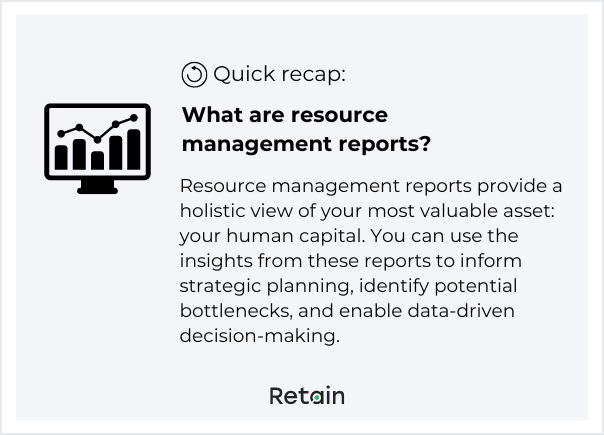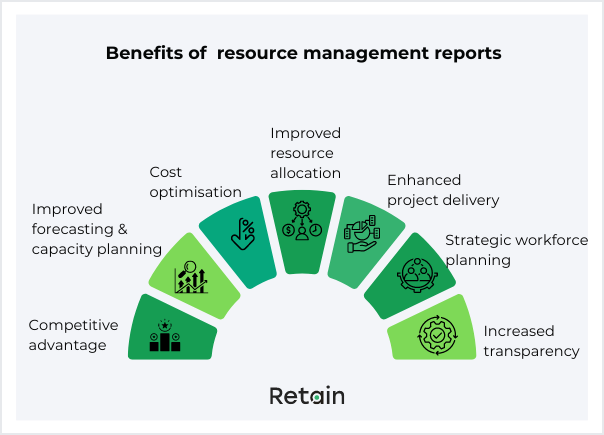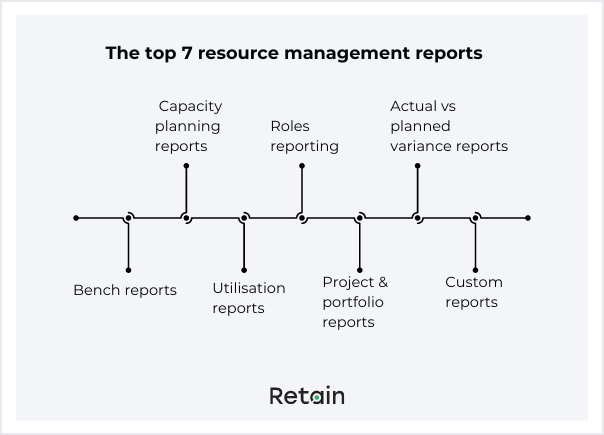It’s no secret that resource management is challenging. In Q1 2024, there was an 18-year high shortage in specialist talent. At the same time, according to Gartner, the average utilisation rate should be below 80%.
As a result, resource planners are being pushed to squeeze as much value out of resources as possible—without overloading them. But getting the balance right is tricky without access to the right data.
From the way you allocate resources to the method of forecasting demand, project prioritisation, and capacity planning, resource management reports help manage resources like a well-oiled machine. Ensuring the perfect balance of resource utilisation and employee wellbeing.
This article shares how—with the top 7 resource management reports.
What are resource management reports?
Resource management reports provide a holistic view of your most valuable asset: your human capital. You can use the insights from these reports to inform strategic planning, identify potential bottlenecks, and enable data-driven decision-making. Resource management reports enable organisations to track things like project performance metrics, such as actual versus planned variance, budget adherence, and milestone progress.

This insight empowers project and resource managers to make informed decisions, mitigate risks, and course-correct when necessary, ensuring that projects remain on track and within budget.
Beyond project-level insights, resource management reporting supports strategic workforce planning by providing a comprehensive view of role demands, skill requirements, and resourcing needs across the organisation. This insight allows you to proactively address talent gaps, upskill existing resources, or secure external talent, ensuring a future-ready workforce capable of meeting evolving business demands.
Benefits of using resource management reports
Resource management reporting plays a key role in optimising your most valuable assets – your people and project portfolios. By leveraging data-driven insights, you can unlock plenty of benefits that drive efficiency, profitability, and sustainable growth.

Key benefits of resource management reporting:
Improved resource allocation
With comprehensive visibility into resource availability, skills, and utilisation levels, you can make informed decisions about assigning the right resources to the right projects, maximising productivity and ensuring optimal resource utilisation.
Enhanced project delivery
By tracking project performance metrics, such as actual versus planned variance and budget adherence, resource management reporting enables you to identify and mitigate risks proactively, ensuring that projects are delivered on time, within budget, and to the highest quality standards.
Strategic workforce planning
By providing a clear overview of role demands, skill requirements, and resourcing needs across the organisation, resource management reporting empowers you to proactively address talent gaps, upskill existing resources, or secure external talent, ensuring a future-ready workforce capable of meeting evolving business demands.
Increased transparency and accountability
With real-time data and comprehensive reporting capabilities, resource management reporting provides transparency and accountability across the organisation, enabling data-driven decision-making and promoting a culture of continuous improvement.
Cost optimisation
By identifying inefficiencies, over-utilisation, and resource constraints, resource management reporting optimises resource allocation, reducing unnecessary costs and maximising the return on human capital investments.
Improved forecasting and capacity planning
With historical data and trend analysis, you can leverage resource management reporting to accurately forecast future resource demands, enabling proactive capacity planning and ensuring the availability of resources when and where they are needed.
Competitive advantage
By optimising resource allocation, enhancing project delivery, and creating a future-ready workforce, those that leverage resource management reporting gain a competitive edge in their respective markets, positioning themselves for long-term success.
Key takeaway: By harnessing the power of data-driven insights, organisations can optimise resource allocation, enhance project delivery, support strategic workforce planning, and drive organisational excellence. Ultimately setting you up for sustainable growth and success.
The top 7 resource management reports
There are a wide range of reports that provide organisations with the insights they need to optimise their resource allocation, enhance project delivery, and drive strategic workforce planning.

Here are the top seven resource planning reports that every organisation should leverage:
1. Bench reports
Bench reports provide real-time visibility into your available resource pool, including individuals who are currently unassigned or between projects. These reports are invaluable for identifying underutilised resources and ensuring that they are promptly assigned to new initiatives, maximising resource utilisation and minimising bench time.
2. Capacity planning reports
Capacity planning reports offer a comprehensive view of your resource capacity, enabling you to proactively identify potential bottlenecks, skill gaps, or resource constraints. By analysing historical data and forecasting future resource demands, these reports empower you to make informed decisions about resource allocation, ensuring the right resources are available at the right time.
3. Utilisation reports
Utilisation reports provide a clear picture of how their resources are being utilised across various projects and initiatives. By tracking the percentage of each resource's capacity that has been scheduled, planned, or used, these reports help surface inefficiencies, identify over-utilised individuals or roles, and enable data-driven adjustments to maintain optimal resource utilisation levels.
4. Roles reporting
Roles reporting dashboards offer a concise overview of outstanding resource demands, categorised by specific roles or job functions. At a glance, you can visualise current and projected role requirements across projects, identify gaps in specific skill sets, and seamlessly track staffing needs over time, enabling proactive talent acquisition and upskilling initiatives.
5. Project and portfolio reports
As the name suggests, project and portfolio reporting provides comprehensive insights into the performance of projects and portfolios. This includes financial metrics, progress tracking against milestones and deadlines, and project health indicators. These reports enable you to identify potential issues early, make data-driven decisions, and ensure that initiatives are delivered on time, within budget, and to the highest standards.
6. Actual vs planned variance reports
Actual vs. planned variance reporting helps you to monitor how projects are tracking against initial plans and budgets. By comparing estimated hours and costs to actual timesheet data, these reports identify variance percentages for labour hours and expenses, enabling you to catch budgetary issues early and take corrective action when needed.
7. Custom reports
Recognising the diverse reporting needs of organisations, resource management solutions, like Retain also offer the capability to create custom reports tailored to specific requirements. These reports can be configured to display the exact data points and visualisations needed, ensuring that you have access to the insights they need to make informed decisions and drive continuous improvement. You can even pull in data from external sources, including HR, CRM, ERP, and Practice Management Software, to import data from different sources and consolidate it within the reporting feature.
Bottom line: The right reports enable you to fully take control of your resource allocation, enhance project delivery, and create a future-ready workforce. (You can find out more about the reports available in Retain’s resource management software here.)
Automate resource management reports with Retain
Resource management reporting is a tough thing to get right manually. By investing in specialist resource management software, manual reporting will be taken off your plate. You’ll improve resource planning accuracy, allocate resources faster, and have the data you need to strategically grow and upskill your talent pool.
Through interactive dashboards and customisable reports, you’ll be able to visualise real-time data on resource availability, capacity, and utilisation levels. This granular level of visibility allows you to proactively identify skill gaps, workload imbalances, and potential resource constraints, so you can take pre-emptive measures and optimise resource allocation.
If this is something you are interested in learning more about, we invite you to book a demo.


